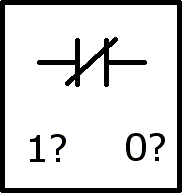Hi there,
I would like to know if anybody can explain how the physical switch is interfaced to the ladder logic program. I would like to understand how, when i use a Normally Closed contact with input address of a switch in my ladder logic program, the output device (light) is turned ON while my physical switch is still Open. And when i close my physical switch the light goes off. I would like to understand how that is happening.
Can anyone explain how the physical switch is interfaced with the ladder logic program to do that?
Thanks
I would like to know if anybody can explain how the physical switch is interfaced to the ladder logic program. I would like to understand how, when i use a Normally Closed contact with input address of a switch in my ladder logic program, the output device (light) is turned ON while my physical switch is still Open. And when i close my physical switch the light goes off. I would like to understand how that is happening.
Can anyone explain how the physical switch is interfaced with the ladder logic program to do that?
Thanks




